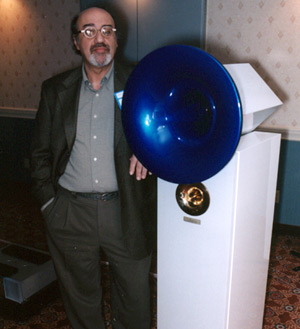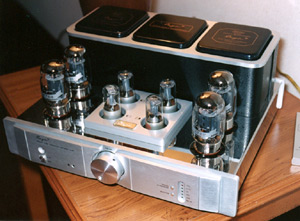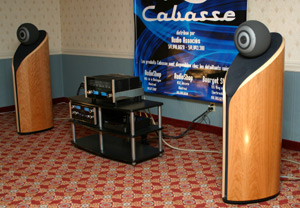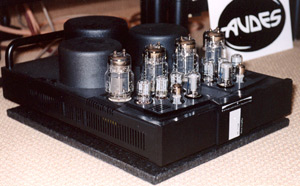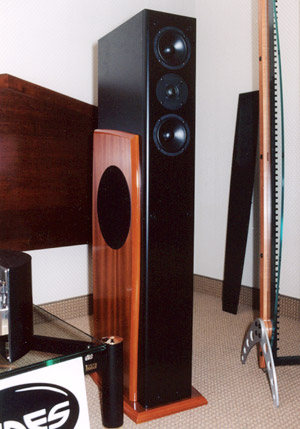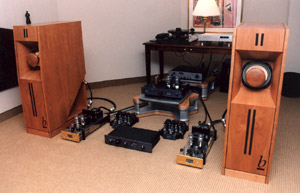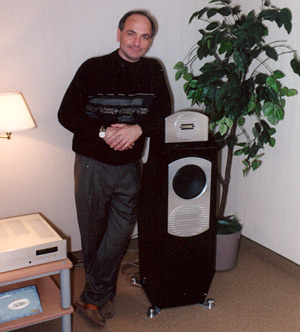 |
|||
| May 15, 2003 Ultra Audio Goes to Son et Image 2003: Part Two
Venerable distributor Tri-Cell Enterprises, from Toronto, fielded two rooms at the show. A rack-full of eye-candy from the popular Synthesis of Italy was on display, as well as a pair of Oskar Heil Kithara loudspeakers in full black-lacquer regalia. The naturalness of the mids and highs generated by the special Oskar Heil "washboard" electromagnetic driver is worth hearing. Both the sound and the driver itself are totally unlike any other speaker technology I am aware of. The visually and sonically stunning Acapella Violon speakers dominated Tri-Cell’s big room. Though they are the smallest of their line, they are still massive, standing nearly six feet tall. The design is a three-way, featuring an acoustic-suspension woofer, a top-mounted front-facing horn-loaded midrange, and a central ion tweeter. The latter uses a continuous high-voltage corona discharge to generate a plasma flame, which vibrates the air by changing in volume according to the musical signal. The plasma flame is nearly spherical and considered essentially massless, allowing excellent dispersion characteristics with near-perfect tracking of the high frequencies. Perhaps coolest of all, the plasma flames are visible in the throats of the brass tweeter horns when in use. If you plan to rush out and buy a pair of Violons, you’d better check with the bank first. They retail at approximately $29,000 USD. Driven by the Accustic Arts Drive I CD transport, a Hovland tube preamp, and the new solid-state Hovland power amp with Shunyata cabling, the speakers provoked effusive comments from the SoundStage! team. "That tweeter sounds like nothing!" gushed Doug Schneider. Indeed, there was a startling realism in the high frequencies, a unique kind of captivating, unfettered treble energy that was in no way bright. The other drivers also acquitted themselves well, particularly with regard to their impressive speed. Though I thought I heard a little "horniness" from the horns, and a tad of overhang in the bass, these could quite easily be dismissed as positioning problems in the overly large room. This exhibit deserved the accolade of Ultra Audio MegaSystem Award, 2nd Place. (If you’re wondering what distinguishes a "MegaSystem" from a "System," systems are of a scale that would fit reasonably in my 12’ x 14’ living room, while MegaSystems like this one are those that would prefer more space.)
A bevy of remarkable and unusual products from around the world were on display in the Allied Distribution room, including very nice-sounding and modestly priced "Abbey" Lowther-type speakers from fine furniture makers Cain & Cain in a Voigt-pipe configuration. These produced good, full bass ($1500 USD). Also playing were the GS-805SE monoblocks from Radii ($2515 USD), which have large glowing 805 tubes, and the beautifully built A-88T stereo integrated amplifier from Cayin of Hong Kong, featuring point-to-point wiring and remote control, for only $1971 USD. French speaker manufacturer Cabasse splurged for a large room in which to feature their highly original Kara speakers, driven by tried-and-true McIntosh tube electronics. The Kara’s sport a largish spherical "head" unit containing tweeter, upper mid, and lower midrange drivers in a triaxial configuration. The head unit is mounted over an upward-firing bass driver atop a ported high-volume columnar enclosure. The effect is certainly visually impressive, suggesting a stylized human form or a giant chess piece. Moreover, there are no removable grilles, which obviates the tradeoff between aesthetics and sound that grilles usually present. Christophe Cabasse himself, a scion of the Cabasse dynasty, was on hand in the flesh. He affirmed my impression that there is a distinct French sound, which came about in part due to the influence of Cabasse in the early days of high-end audio in France. As a JMlab owner myself, I would describe this sound as somewhat forward with an overall vividness and openness, to some extent sacrificing refinement in the details for realism in the big picture. The Karas showed some of this lineage, though with much greater refinement than I am used to from my Electras. The triaxial driver configuration delivered on its promise of point-source imaging to a startling degree, producing a soundstage that I would describe as genuinely life-size, without oversizing of the individual instruments or voices. The presentation was vivid, but not forward, remaining at or behind the speaker plane, yet energizing the room in a very satisfying way. Bass was taut and highly localized at the bottom margin of the soundstage, rather than emanating from the floor as it often does with woofers that are not upward firing. The price of admission for the Karas is $14,000 USD. This MegaSystem provided an extremely satisfying experience, and received the Ultra Audio MegaSystem Award, 1st Place. The last of the MegaSystems for this show was displayed in its full glory in the Triangle room, another well-regarded French speaker manufacturer. Driven biamplified by Cairn electronics, including the current-spec Fog CD player (which upsamples to 24/192 and retails at $1695 USD), the Magellan speaker system consists of two slim columns of polished wood, each about a foot wide and around seven feet tall. These $33,000 USD speakers produced a cavernous soundstage in terms of both depth and breadth, with tremendous, almost excessive, delicacy in the highs. Sunday, March 30, 1:00 a.m. Giggling like schoolgirls, normally staid SoundStage! pundits concoct a sorority prank in the hallway outside our rooms. Claiming to be otherwise butt-naked, Doug Schneider dons my expensive overcoat (henceforth, the Ultra Audio Ultra Coat) and strikes a pose reminiscent of the Cabasse Kara speaker while I snap a picture (clucking disapprovingly). I think it may have been Marc Mickelson's idea, though he will almost certainly deny responsibility. He remained fully clothed throughout.. Unfortunately, I did not have the presence of mind to capture Wes’s entrance into the fray, fetching though he was in his stockings and underwear. Versions of the resulting digitally altered Kara/Schneider Picture of the Day can be seen in all their tasteful glory on SoundStage! LIVE. 12:01 p.m.
The excellent reputation of Balanced Audio Technology (BAT) in the preamp- and amp-manufacturing domain is well known. On exhibit was the new VK-75SE amp ($8500 USD) together with their VK-51SE preamp ($8500 USD plus $500 for the remote option) and VK-D5SE CD player ($6000 USD). These were mated to a pair of modestly priced Audes Blues loudspeakers, which hail from Estonia and will set you back a mere $2100 USD. Musician and sales director Geoffrey Poor of BAT acted as master of ceremonies, explaining that the 6H30 "supertube" was considered the most linear tube available by BAT chief designer Victor Khomenko and is used in the gain stages of most BAT equipment. In case you haven’t been reading your Pravda lately, the 6H30 was recently declassified by the Russian government and has gone into current production. Output tubes on the VK-75SE are the squat, dual-nippled 6E33Bs driven, in a balanced configuration of course, by BAT’s special circlotron topology. What do I have to say about the sound in this small room? How about stupendous, exhilarating, and irresistible? I would also venture liquid, coherent, and natural. The side-firing bass emanating from those Baltic beauties rocked my world, as did overall tonal accuracy, imaging, and high-frequency purity. Apart from a touch of midrange compression, this system produced unimpeachable sound and was deserving of the coveted Ultra Audio System Award, 1st Place. The visually imposing Beauhorn single-driver speakers ($6000 USD) were exhibited together with electronics from Manley. Manley gear boasts unmistakably retro styling with generously vented gunmetal chassis and an oversized logo. The Neo Classic SP/PP 300 B single-ended amp, priced at $7200 USD, was on display. Down the hall, the tri-nipple 6C33 output tube again appeared in the shiny-chromed cages of the Phoenix Acoustics Corporation SE15 Revelation monoblock amplifiers ($8500 USD). Finally, Oracle Audio Technologies’ designer Jacques Riendeau showed off his company’s prototype for a radical re-entry into the speaker market. The new model is a non-conventional two-way, in which the main driver is a custom Supravox 8.5" full-range driver that crosses over to a Phillips ribbon tweeter at around 6kHz. An internal transmission line vents out of the upper rear to reinforce bass frequencies. Estimated retail for the speaker is $12,500 USD. The system was driven by the modestly priced Stello line of Oracle electronics (CDA200 CD player, $2750 USD and AI300 150W integrated amp, $3250 USD). Despite a few quibbles in the midrange, there were signs of potential greatness from this refreshingly original design. The high frequencies floated beguilingly over the soundstage, and the midbass region was extraordinarily transparent. I heard the woody details of a percussion instrument at the start of James Taylor’s "Jump Up Behind Me" (Hourglass) seemingly for the first time. Also on display were the haute gamme Delphi line of stunningly attractive products, including the venerable Mk5 turntable, granite version ($5000 USD), the non-spring-suspended version of their CD transport, the CD1000 ($4350 USD), and the CD2500 CD player ($9845 USD). 6:00 p.m. The show winds down, but I do not leave empty-handed. With the help of the brawny men of SoundStage! (thanks again, gentlemen), I make my getaway with a van full of the Acapella Violon speakers (a full review will appear on Ultra Audio just as soon as I can pick my jaw up off the floor). Wresting those pricey lassies from Vince of Tri-Cell was definitely a coup. I may not be cool, but I have giant horns in my living room that emit poison gas. For those who have not attended a show before and who can’t get enough of high-end gear, make next year’s Festival Son et Image a priority. My thanks to all the fine folks who exhibited and took the time to chat, and congratulations to all on another fine show. ...Ross Mantle
Ultra Audio is part of the SoundStage! Network. |
